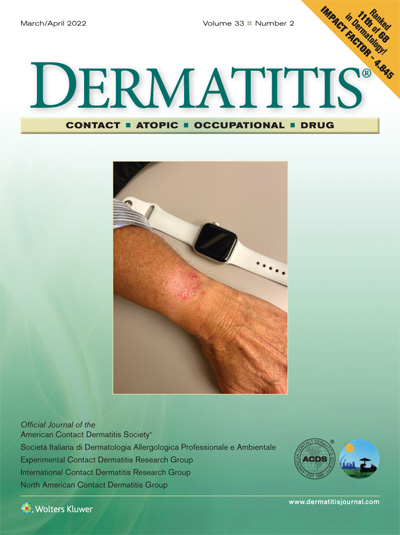Toxic Ingredients in Personal Care Products: A Dermatological Perspective.
IF 3.2
3区 医学
Q1 DERMATOLOGY
引用次数: 0
Abstract
Environmental dermatology is the study of how environmental factors affect the integumentary system. The environment includes natural and built habitats, encompassing ambient exposure, occupational exposures, and lifestyle exposures secondary to dietary and personal care choices. This review explores common toxins found in personal care products and packaging, such as bisphenols, parabens, phthalates, per- and poly-fluoroalkyl substances, p-phenylenediamine, and formaldehyde. Exposure to these toxins has been associated with carcinogenic, obesogenic, or proinflammatory effects that can potentiate disease. In addition, these compounds have been implicated as endocrine-disrupting chemicals that can worsen dermatological conditions such as acne vulgaris, or dermatitis. Certain pollutants found in personal care products are not biodegradable and have the potential to bioaccumulate in humans. Therefore, even short-term exposure can cause long-lasting issues for communities. The skin is often the first point of contact for environmental exposures and serves as the conduit between environmental toxins and the human body. Therefore, it is important for dermatologists to understand common pollutants and their acute, subacute, and chronic impact on dermatological conditions to better diagnose and manage disease.个人护理产品中的有毒成分:皮肤病学视角。
环境皮肤病学是一门研究环境因素如何影响人体皮肤系统的学科。环境包括自然栖息地和人造栖息地,包括环境暴露、职业暴露以及因饮食和个人护理选择而产生的生活方式暴露。本综述探讨了个人护理产品和包装中常见的毒素,如双酚、对羟基苯甲酸酯、邻苯二甲酸盐、全氟和多氟烷基物质、对苯二胺和甲醛。暴露于这些毒素与致癌、致肥胖或促炎作用有关,可加剧疾病。此外,这些化合物还被认为是干扰内分泌的化学物质,会加重痤疮或皮炎等皮肤病。个人护理产品中的某些污染物不可生物降解,并有可能在人体内进行生物累积。因此,即使是短期接触也会给社区带来长期问题。皮肤通常是接触环境的第一接触点,也是环境毒素与人体之间的通道。因此,皮肤科医生必须了解常见污染物及其对皮肤病的急性、亚急性和慢性影响,以便更好地诊断和管理疾病。
本文章由计算机程序翻译,如有差异,请以英文原文为准。
求助全文
约1分钟内获得全文
求助全文
来源期刊

Dermatitis
医学-皮肤病学
CiteScore
5.30
自引率
11.50%
发文量
251
审稿时长
>12 weeks
期刊介绍:
Dermatitis is owned by the American Contact Dermatitis Society and is the home journal of 4 other organizations, namely Societa Italiana di Dermatologica Allergologica Professionale e Ambientale, Experimental Contact Dermatitis Research Group, International Contact Dermatitis Research Group, and North American Contact Dermatitis Group.
Dermatitis focuses on contact, atopic, occupational, and drug dermatitis, and welcomes manuscript submissions in these fields, with emphasis on reviews, studies, reports, and letters. Annual sections include Contact Allergen of the Year and Contact Allergen Alternatives, for which papers are chosen or invited by the respective section editor. Other sections unique to the journal are Pearls & Zebras, Product Allergen Watch, and news, features, or meeting abstracts from participating organizations.
 求助内容:
求助内容: 应助结果提醒方式:
应助结果提醒方式:


